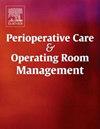经手术调整的术后住院发生率与麻醉师临床监督质量或麻醉护士工作习惯的差异无关
Q2 Nursing
Perioperative Care and Operating Room Management
Pub Date : 2024-10-24
DOI:10.1016/j.pcorm.2024.100441
引用次数: 0
摘要
背景麻醉部门可能会受益于自动化的计算机方法来监控麻醉医师的临床表现。非住院手术后入院(住院一晚)可能是一个合适的衡量标准,较高的发生率可能与较差的临床表现有关。方法这项回顾性队列研究使用了一家医院八个财政年度的数据,对麻醉临床护理质量的两种不同指标进行了每日评估。其中一个变量是由受训人员(主要是住院医师)评估麻醉医师的临床监督情况。第二个自变量是麻醉护士的工作习惯,由麻醉医师进行评估。这些自变量均为二元变量,即每年计算的评分者宽松度调整后所有项目最高绩效的评价比例。因变量是根据手术室和手术类别调整后,术后住院时间少于 1 天的受评病例(麻醉师或麻醉护士)的比例。因此,对于自变量和因变量而言,对数越大(正对数)表示 "好",对数越小(负对数)表示 "坏"。斜率的估计符号为临床监督质量对数的增加与患者住院时间≤1 天的概率对数的非显著下降相关。同样,麻醉护士工作习惯对数的增加与患者住院时间≤1 天的概率对数呈负相关,但不显著。麻醉医师和麻醉护士之间的比较不应以其病人在非住院手术后经手术调整后入院的风险是否高于预测值为依据。本文章由计算机程序翻译,如有差异,请以英文原文为准。
Procedure-adjusted incidences of postoperative hospital admissions are not associated with differences in the quality of anesthesiologists’ clinical supervision or nurse anesthetists’ work habits
Background
Anesthesia departments may benefit from automated computerized methods to monitor the clinical performance of individual anesthesia practitioners. Hospital admission (>1 night stay) after ambulatory surgery may be a suitable metric, with higher incidences potentially being associated with poor clinical performance. If valid, there should be a small but statistically significant association of postoperative admission with previously validated measures of quality of intraoperative anesthesia care.
Methods
This retrospective cohort study used eight fiscal years of data from one hospital with daily assessments of two different measures of quality of anesthesia clinical care. One variable was anesthesiologists’ clinical supervision evaluated by trainees, principally residents. The second independent variable was nurse anesthetists’ work habits, evaluated by anesthesiologists. These independent variables were binary, the proportions of rater-leniency-adjusted evaluations with maximum performance for all items, calculated annually. The dependent variable was the proportion of ratees’ cases (anesthesiologist or nurse anesthetist) with postoperative length of stay ≤ 1 day, adjusted for surgical suite and procedure category. Thus, for both independent and dependent variables, larger (positive logits) were “good” and smaller (negative logits) were “bad.”
Results
There were no significant associations for either supervision (P =0.14, N=561 anesthesiologist-years) or work habits (P =0.74, N=598 nurse anesthetist-years). Estimated signs of the slopes were for increases in the logits of the quality of clinical supervision to be associated with non-significant decreases in the logits of the probabilities of the patients having lengths of stay ≤1 day. Similarly, increases in the logits of nurse anesthetists’ work habits had negative-signed non-significant associations with the logits of the probabilities of the patients having lengths of stay ≤1 day.
Conclusions
The results show with substantial certainty that higher-performing anesthesia practitioners do not have briefer lengths of stay. Anesthesiologists and nurse anesthetists should not be compared among one another based on whether their patients have a greater than predicted risk of procedure-adjusted hospital admission after ambulatory surgery.
求助全文
通过发布文献求助,成功后即可免费获取论文全文。
去求助
来源期刊

Perioperative Care and Operating Room Management
Nursing-Medical and Surgical Nursing
CiteScore
1.30
自引率
0.00%
发文量
52
审稿时长
56 days
期刊介绍:
The objective of this new online journal is to serve as a multidisciplinary, peer-reviewed source of information related to the administrative, economic, operational, safety, and quality aspects of the ambulatory and in-patient operating room and interventional procedural processes. The journal will provide high-quality information and research findings on operational and system-based approaches to ensure safe, coordinated, and high-value periprocedural care. With the current focus on value in health care it is essential that there is a venue for researchers to publish articles on quality improvement process initiatives, process flow modeling, information management, efficient design, cost improvement, use of novel technologies, and management.
 求助内容:
求助内容: 应助结果提醒方式:
应助结果提醒方式:


